As we travel on our career paths, we will inevitably encounter events that alter our course and lead us in a direction we may never have seen coming. This evolution of a belief system, or philosophy, is sometimes presented to us when we least expect.
These events can make us wonder, “Is this what is best?” Have I been missing some key pieces that can make my skill set more effective? Can I blend this into my existing methodology? When faced with some of these experiences that make us take notice, the ones that are truly significant professionally, there are options:
- Some of us will sit up for hours or weeks at a time and try to poke holes in what we have learned to test its validity and determine for ourselves if this information has relevance.
- Some of us will shoot it down immediately because it does not echo or support what we are doing today.
- And some of us are not aware that an amazing learning opportunity just passed us by.
When I first met Pavel, when I was a rookie NFL strength and conditioning coach facing questions and challenges, he forced me to decide which of these three scenarios I would choose.
My First Challenge as an NFL Strength Coach
It was a little over ten years ago, and I had been in the performance business as a strength and conditioning coach for close to fifteen years. I had great success learning and growing through the collegiate and professional ranks. I was challenged with my first, and maybe only, opportunity to lead an NFL team as a Head Strength and Conditioning Coach.
I had developed thousands of athletes during my career and felt confident to do it at the highest level of sports. However, there were always questions in the back of my mind that I could not answer through the textbooks and historical reading I would flood myself with. The periodization books I had learned from did not always produce the results as promised with all my athletes. I could not figure this out, as some of these athletes were my hardest workers. I knew there were gaps in my system and it drove me crazy. How do I manage this? How can I produce results and shield the professional athlete from these gaps? It was like trying to hide the scratch you put on your parents’ car.
That’s when two lights flashed for me: the FMS and the kettlebell.
For the purposes of this article, I will discuss the kettlebell and its role in my athlete development process. I was fortunate to be introduced to Pavel many years ago, at almost the same time I implemented the FMS with a full team. I knew from my first conversations with Pavel that he and I shared many common beliefs. He had a toolbox that looked similar to mine, but his contained something different — that different tool broadened my scope of athlete development.
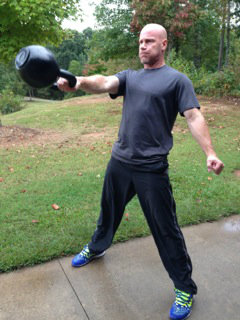
Introducing the Kettlebell to Elite Athletes
My introduction to the kettlebell was challenging, humbling, and inspiring. As I obsessed with trying to learn the basic movements, I knew it was changing how my body felt. But I had to master these movements before teaching it to any athletes. I also knew the athletes had to experience immediate success in order to keep their attention, and be able to add movements in the future. It had to be challenging and fun, I wanted them to realize after they sat at their locker following a workout that the kettlebell had snuck up on them and crushed them – the afterburn!
I began implementing a few movements that I thought many of the athletes could benefit from based on our team deficiencies, and what I felt comfortable teaching to eighty athletes by myself. So I began with armbars, front squats, and single- and double-arm deadlifts. I prescribed these to the athletes with specific needs, trying to address shoulder, core, and lower body issues.
What I saw was shocking.
Elite-caliber athletes were wrestling with a 16kg kettlebell as they tried to stabilize an armbar. Some of these athletes were 400+lb barbell bench pressers. The greatest element in this experience for the athlete was the feedback they were receiving from the kettlebell – the kettlebell became an assistant coach for me. It reinforced my words that the athlete had a deficiency they had to improve upon in order to reduce the risk of injury. Now all I needed to do was supply the proper challenge to each athlete. This led to an increase in athlete interest in their own training and elevate the amount of individualization they received, and this all led to a significant increase in athlete motivation.
As I detailed each athlete with their technique and followed each movement with loaded patterned movements, I began to realize something exciting. I could see with my own eyes the movement abilities of the athletes improving. I could see increased mobility and greater control during heavy exercises – and with this, greater strength and power outputs with less discomfort during and after workouts.
I can’t tell you how many times I heard from other peers in the coaching world that focusing on movement was a waste of time and it could not be implemented in team sports. Meanwhile, I was doing it on a daily basis and seeing the benefits. Now that does not mean my teams were not training with weights.
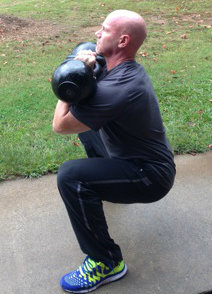 Some people believe training is an either/or proposition. For example, either you train with weights or machines. If you train with weights, then you have to go heavy all the time. If you subscribe to Olympic lifts, that’s all you use to train your athletes. If you mention the word “corrective exercise,” then you must only use bands to train with.
Some people believe training is an either/or proposition. For example, either you train with weights or machines. If you train with weights, then you have to go heavy all the time. If you subscribe to Olympic lifts, that’s all you use to train your athletes. If you mention the word “corrective exercise,” then you must only use bands to train with.
These are generalizations, but back then these statements tended to lump strength and conditioning coaches into categories. So I had an identity crisis. I was training with barbells, doing Olympic lifts and explosive training, utilizing kettlebells for many training objectives, and bouncing it all off movement assessments to hold myself accountable.
I began to implement more exercises: military press, get-up, swings, single-sided and bottoms-up variations of presses, squats, and single-leg movements. Now we were using the kettlebell as part of our corrective exercise, our strength training, and our conditioning. I started to refine my programming and set/rep/rest schemes accordingly. I used myself, my staff, and proper direction from Pavel before implementing.
However, in the early years, I needed more information before team implementation of new concepts. I wanted to get a sense of the subjective elements the training was producing, and I wanted to see the influences of the training on different body types. I knew what I felt and experienced, but I wanted to get some unbiased observations thrown in as well.
My Experiment: The NFL Practice Squad
In the NFL, you have a small group of athletes assigned to what is called the Practice Squad. The Practice Squad members are part of the team and have a valuable role. They do not play in the games, but they provide the team with a look at the upcoming opponents’ tendencies and tactics. They practice hard while running the plays the coaching staff feels the opponent may try to use.
I took the same approach with the practice squad. My passion is athlete development, and I wanted to develop each of them beyond what other teams were doing in order to help them reach their goals, which is being a member of the active roster as soon as possible. I would implement new kettlebell exercises and methods with the practice squad during the season as a preview to what methods I would utilize with the team in the following off-season. If I found positive results with the Practice Squad in the fall, I would feel great about inserting the new plan into the team in the spring. This approach can also be used at the college level with the red-shirt athletes.
The Get-Up
I mention this because during one season, another light flashed for me. While working with the Practice Squad, I noticed they all were moving exceptionally well over a short period of time. I had recently spent a few weeks detailing an exercise in a slow, painful way. I wanted the athletes to nail this highly-technical movement. These athletes had been through numerous movement assessments and I had a good idea of how each of them moved as they were with me for fourteen weeks before the season, and some for multiple years. But this group started to look different in terms of their movement efficiency than the other athletes on the active roster who were also doing their corrective exercise program.
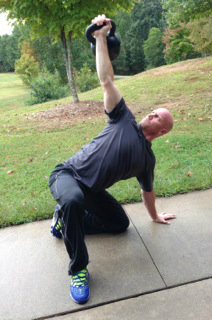
The only difference within the workouts was one exercise: the get-up. I dedicated an entire session, one day a week, to this exercise with the Practice Squad. We began by getting rock solid at the half get-up, then progressed as each individual showed competency.
The implementation of the get-up raised the average improvement on our movement assessment – the improvements were not achieved with more corrective exercises, as I once believed. I had just learned a valuable lesson that allowed me to take my program to a higher level of movement efficiency.
The Impact of the NFL Lockout
That brings me to another significant event that also showed me how much I could truly influence movement. First, we have to track it with precision. I had compiled many years of data when the NFL lockout struck in 2011. That basically meant all the athletes had to train on their own away from the team training facility and I was not able to have any contact with them until the lockout lifted.
It lifted just as Training Camp was to begin, not giving me any time to prepare the athletes for the most demanding portion of the yearly schedule. The injury risk numbers had risen to a level I had never before witnessed as the athletes had been away for up to seven months. My plan was to go all-in on reducing these risk factors as quickly as possible.
Another significant event was born from this lockout, in the following off-season period, the amount of time I would be allowed with the athletes would be reduced significantly. I knew what I had done in the past to positively influence movement, but this would have to change completely. My challenge was clear: how to continue to improve movement and performance output with severely limited time.
I remember having a coffee with Pavel discussing my plan and asking for his expertise on this. In his brilliant way, he helped me walk through the plan. There were a few obstacles to navigate in order to reach my goals. The obstacles included:
- Less time with the athletes
- No interaction with the athletes for four full months prior to the off-season
- I no longer had the ability to condition the athletes as part of my lifting and running plan as in previous years
- The athletes would be asked to be in competitive situations much sooner than in the past (injury risk factors now more in play)
- My training, although in the non-competitive time of the year, was taking a back seat to on-field practice
I knew I had a responsibility to prepare the team above our previous standards with fewer resources. The solution was to install a general preparation program that accomplished these goals quickly. I needed to enhance strength, power, muscle mass, metabolic conditioning, flexibility, and reduce body fat and risk factors. An eight-week all-kettlebell collision course was adopted.
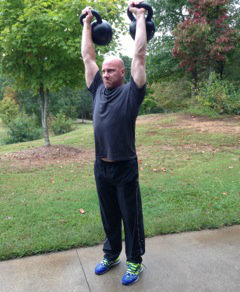 The 8-Week Kettlebell Collision Course Plan
The 8-Week Kettlebell Collision Course Plan
I spent many weeks teaching the exercises and progressions to my two-person staff before the athletes arrived to start the program. The first week was spent teaching the techniques of the base kettlebell exercises and performing our battery of tests and assessments. Not surprisingly, after not having contact with our athletes for four months, their scores were below what we had seen in previous years. We used a four-day-a-week plan with single kettlebell movements used on one day, double kettlebell movements used another day, the get-up and windmills on another day, and numerous complexes and chains (metabolic) on another.
I began to notice drastic changes after three to four weeks. I recognized our techniques improving, the weights began to increase to impressive amounts, the competitive energy in the weight room was electric, and many athletes were telling stories of the daily naps that hit them out of nowhere.
Another amazing sight was watching the reduction in time spent returning the heart rate between sets of swings, cleans, and snatches. We would monitor heart rate on our metabolic day and only allow an athlete to begin the next set when their heart rate returned to the assigned value. All heart rates were displayed on a screen and the athlete watched his numbers lower, then started the next set. By week eight, the team had achieved a conditioning level beyond expectations. To watch how quickly a team of eighty athletes could lower their heart rate was impressive – it was an accumulation of all the drills done during the week.
Lessons Learned
Then, I got another flash of light, a “what the hell effect” moment. After analyzing the data gathered at the end of the program, I realized we achieved a greater overall team improvement in movement efficiency than in any of the previous off-season programs. Now I realized, we were stronger, more explosive, leaner, could work all day and recover quickly, and our movement quality had increased dramatically.
How could that happen in less time than in previous years? We did less corrective exercises than ever? I realized that even when we don’t see them at first glance, circumstances force us into the greatest learning lessons imaginable. I was worried about the challenge, the obstacles where enormous, but I gained a tremendous amount of insight into human movement and performance.
I incorporate those lessons into each athlete/client/team I work with today. I have learned that less can be more in most situations and knowing the key elements of movement can improve performance quickly. I’ve learned that filling in a gap in your overall methodology, or into an individual’s profile, will always be a benefit.
There is a special feeling you get when you spend countless hours preparing your team or clients to the proper techniques of kettlebell training. I remember seeing three of my athletes with completely different body types performing front squats and all three had identical postures and joint angles at the torso, hip, and knee. One of these athletes was 5’8”, the second was 6’1”, and the third was 6’7”, and they all looked like the same body that had been copied at different sizes.
Or the amazing sight when you have a line of athletes all doing kettlebell swings and as you stand to the side and they suddenly synchronize their movements and several athletes now move as one with perfect hinging mechanics. These are training memories that are magical – these snapshots are reflections of the quality work you have put in to coaching.
In this day and age of new technology, new exercise equipment, and specialization at a premium in youth sports, it is ironic how the oldest tool in training still lends the greatest number of benefits. Let’s all of us continue to be great teachers of technique and safety, and influence others to the world of benefits of this simple tool.

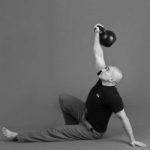



Coach,
I am a younger football player and I am struggling to find an off season workout program. I’ve tried multiple things like dumb bells, etc. but I like the kettlebell more because it takes a lot less time and is great full body workout. I was wondering if you can give me some exersizes that you recommend most.
Coach Fish,
My comment is more of a question. During your description of “The Plan” you say that your athletes were using kettlebells 4 days per week. Were you also doing other exercises with barbells during this time, or was your time solely devoted to the kettlebell? The reason I ask is I’ve heard another NFL strength coach say that with his veteran athletes he will substitute all barbell squats with double kettlebell front squats. Just curious. I love the article. Thank you for taking time to put “pen” to paper.
-Kevin
Hi Kevin, thanks for the question.
In this particular example, I was using 100% kettlebells. I had not had any contact with my athletes for 4 months and installed this general preparation block to address movement quality and work capacity. I knew I would have some movement impaired athletes with low work capacities returning, and being demanded to work long and hard on the field (a perfect injury storm). My plan was to ensure we had addressed any mobility deficiencies, movement restrictions and/or asymmetries, and to increase work capacity. The KB gave me a variety of options that expanded on what I had used in the past. Some additional information – after this block was completed and the results were analyzed, I felt confident that the team had developed appropriately and we had accomplished our initial goals. Then we transitioned into our specific physical preparation stages where we utilized other training tools (barbells, dumbbells, etc) in addition to KB’s. Hope this helps – stay strong!
Thanks, Coach. Great response and insight. I wish you the best in 2015.
Jeff this is an awesome read. In this article you eloquently demonstrate how the emphasis on fundamental movements with the kettle bell can heighten the performance of every individual; even when millions of dollars are involved among the participants.
Fundamental quality movement emphasis is huge, but with the kettle bell there are ways of honing in and emphasizing those movements in a much more profound way. You hit the nail on the head by saying the kettle bell was a like an assistant coach for you. It forces the participant to find their physical intelligence when in the middle of pursuing mastery of a particular movement.
It’s great to read your article here on the StrongFirst site my friend. As a friend and colleague I hope to have coffee again soon to talk more about the mastery of this killer device. Great share and stay strong.
Great stuff Coach Fish!!! We teach all our high school athletes how to swing & TGU as well as goblet squat. We also had amazing results with using the Bottoms Up Press with our football skills guys(qb/rb/wr). The teams love seeing articles like this as fact that they work at the highest levels. Thanks again!
I appreciate how thorough you were in your above responses to follow-up questions. I work with athletes – collegiate and club, generally – individually and have had similar WTH experiences sneaking in KB work to their training. You make a few notes that I am interested in implementing, namely a “KB Academy” approach to working the basics.
More than anything, the unfortunate point that strength coaches like to have their “one thing” and get lumped into categories – as do fitness professionals – is a poignant one, and it reminds me that I’ve been most successful when I’ve taken Dan John’s approach to answering what I use in my programs: “It depends.”
Excellent article on programming for athletes, and thanks for the equally informative responses.
This is one of the best pieces of writing on exercise programming I have ever read. Educated observations backed by empirical data proves the results – simple and sinister. Do not over – analyze or think it, put in the work and achieve the results!
Hey Jeff,
Very interesting article. Have most NFL teams integrated KBs into their training regimens? And have any used KBs and Pavel’s methods as the foundation of their training in the way you did after the lockout?
Thanks,
Tim
Hi Tim,
Thanks for the response. I cannot speak for what other teams do during their off-season training. I do know that when I implemented my plan there were very few teams that implemented extensive kettlebell methods, maybe an exercise here and there.
Very inspiring. I find it difficult to explain the effectiveness of kettle bell training to new clients. You have highlighted all the benefits with proven well documented results. Thank you.
pavel is the best
Can you go into more deal as to what exercises rep/set scheme you did on the single, double and complex days.
Hi Brad,
I appreciate your question. Please keep in mind there were specific preparatory movements done before any of the sessions began and many of the athletes were at different levels of proficiency while advancing though the program. It was almost like a KB Academy, for example, starting at 1/2 TGU and 1/2 Kneeling Windmills and advancing to some pretty amazing full blown efforts by week 8. I will outline the basics of each day below:
The single and double days were geared around the grind movements with total reps landing between 15-30. Also on those days I would randomize a conditioning movement at the end – for example a KB Swing, KB Snatch, KB Push Press, etc performed for a randomized duration for maximum reps. The athlete did not know what to expect from exercise selection to how long he would have to perform the movement…lots of long faces after a tough grind session when they earned the right to do 12 minutes of double KB swings and had a goal for rep completion. The conditioning work was also consistent with the theme of single or double limb movements.
After two consecutive days of this training, the athletes physically and mentally looked forward to our TGU/WM day. Here I kept the reps under 10 total and detailed the technical and transitional elements.
On the complex days we completed a total of between 60-150 reps of different exercises linked together with rest intervals determined by individual heart rate. It was a fast, intense session that finished the weekly plan.
Hope this helps. Let me know if I can help further.
Very interesting article.
I remember an interview a few years back with hall-of-fame-bound TE Tony Gonzalez about his favorite off-season workout and it was simply (and sinisterly) sets of 2-hand swings with push-ups interspersed in between while the heart-rate dropped, so while reading this article I was guessing at the back of my mind that the work Fish described post-lockout was done for the Atlanta Falcons, and was happy to find my intuitions were correct.
Great article delivered by a great coach.
Amazing article! Thanks!